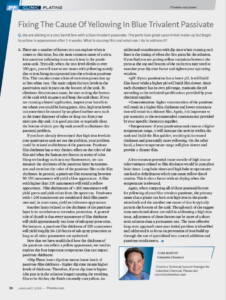Technical & Safety Data
Log in or sign up to access technical data, safety data, applicator approvals and troubleshooting guides.
When parts look great upon initial make-up, but begin to yellow in appearance after 2-4 weeks, Chad Murphy from Columbia Chemical says it can be a number of factors.
Products Finishing
Expert Clinic/Plating
Chad Murphy, Technical Account Manager ~ Columbia Chemical
Q. We are plating in a zinc barrel line with a blue trivalent passivate. The parts look great upon initial make-up but begin to yellow in appearance after 2-4 weeks. What is causing this and what can I do to address it?
A. There are a number of factors you can explore when it comes to this issue, but the most common cause of a trivalent passivate yellowing is too much iron in the passivation tank. Typically, when the iron level climbs to over 100 ppm, you will start to see issues with yellowing mainly due to iron being incorporated into the trivalent passivate film. This can also cause a loss of corrosion protection up to first white rust. The main culprit for iron levels in the passivation tank is parts on the bottom of the tank. To eliminate this common cause, be sure to drag the bottom of the tank with magnets and keep the tank clean. If you are running a barrel application, inspect your barrels to see where you could be losing parts. Also, high iron levels can sometimes be caused by un-plated surface area such as the inner diameter of tubes or drag-out from your nitric pre-dip tank. It is good practice to regularly clean the bottom of nitric pre-dip tank as well to eliminate this potential problem.
If you have already determined that high iron levels in your passivation tank are not the problem, your problem could be related to thickness of the passivate. Passivate film thickness has a very distinct effect on the color of the film and what the human eye detects in terms of color. Using technology such as x-ray fluorescence, we can measure the thickness of the passivate layer in nanometers and correlate the color of the passivate film to the film thickness. In general, a passivate film measuring between 50-150 nanometers will yield a blue appearance. A film with higher than 150 nanometers will yield a yellow appearance. Film thicknesses of >200 nanometers will yield green and pink colors from the spectrum. Passivates with >200 nanometers are considered thick film passivates and, in most cases, yield an iridescent appearance.
Another factor related to the thickness of the passivate layer is its correlation to corrosion protection. A general rule of thumb is that every nanometer of film thickness will yield approximately one hour of salt spray protection. For instance, a passivate film thickness of 100 nanometers will yield roughly 96-120 hours of salt spray protection as long as all other parameters are optimized.
Now that we have established how the thickness of the passivate can reflect a yellow appearance, we need to explore the four important components that can impact passivate thickness:
A less common potential cause outside of high iron or color variance related to film thickness would be post plate bake times. Long bake times and high bake temperatures can lead to dehydration which can cause yellow discoloration. This is also a factor with air drying when the temperature is elevated.
Again, when comparing all of these potential factors for yellowing of your blue trivalent passivate, the primary cause that a plater can look to is high iron in the passivation bath and the number one cause of that is typically parts in the bottom of the tank. Though each of the suggestions mentioned above are valid in addressing a high iron issue, adjustment of these factors can be more of a short-term solution than a permanent one. The most effective long-term approach once your initial problem is identified and addressed is to focus on prevention of iron build up through the use of specialized iron control additives and passivate conditioners.
This article was published in the January 2019 issue of Products Finishing magazine.